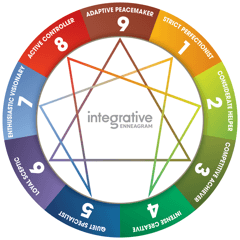Enneagram
Greek for ‘Nine pointed Star’
A useful model of character traits, motivations and behaviours called one’s ‘Type’, – this includes Nine ways of being, with predictable shifts, depending on levels of stress and progression in self-development and awareness. There is a loose correlation with DSM-defined Mental illness, where a pathological level of type exists. The idea is that we all have the capacity to grow our selves and integrate aspects of all types, once we learn to be present in the moment and accept that we have taken on a mask, of sorts that we have worn our entire lives , as a kind of defense, protecting and shielding who we truly are – ” our essence”.
When you realise that your personality isnt really you – that its a tool – this is the most liberating moment of your life.

It all begins with a Circle.
The enneagram is a sacred geometrical structure , consisting of a circle, a triangle and a hexogram.
Head Centre
Five, Six and Sevens – they fixate on the future, and have issues with anxiety.
Here we see ADD, Manic Depression, GAD, Paranoia, Aspergers and even Schizophrenia….. but also Actuaries, Advertising execs, Creative musicians, Loyal soldiers, and brilliant scientists
Body Centre
Eight, Nine and One – these are not past nor future oriented, yet they resist the present. They all have Anger issues. Here reside the Obsessive-Compulsives, Dissociative Disorders, Passive-Agressives, and Sociopaths, together with Magnanimous Patrons of the arts, Presidents, judges and Advocates of the people
Heart Centre
Two, Three and Four – focus on the past, and have issues with shame.
Here are our motherly types, nurses, business execs, famous icons, romantic poets, and Motivational Speakers……..but also the Conversion Disorders, Burnout sufferers, Depressives, Histrionics, Borderlines, and Psychopaths
Dynamic Enneagram
The great thing about learning personality through the enneagram , is the idea of ‘movement’. Nobody gets stuck in a box like a diagnosis that is fixed. In my day , the teaching was that a patient is either “Mad’, “Bad”, or “Sad”, and that their ways of perceiving the world and behaving were relatively fixed.
In extreme cases of pathology this is likely the case , but most people benefit from the Enneagram approach, which allows for movement to different “levels ” of your own type, as well as movements up or down “arrows” to take on certain qualities of another type, which layer their own.
Even though one never changes ‘base type’, at least its seen that there are myriad ‘colorings’ or manifestations, which are subtle, but recognizable. People can learn to notice themselves when in a not-so-healthy space. There are defined areas where people can work on themselves to become ‘their best self’.

Test Your Type
There are many enneatests to be found, they are fun to try, but I don’t put much faith in the result. The questions are too ambiguous, but also the trick is to slowly over time start to recognise your own default pattern. If you do decide to test, here is the one that I recommend
My affiliates at Integrative enneagram solutions offer a comprehensive assessment tool, and provide a thorough report on your type in all three realms. This includes useful suggestions on how to develop on identified strengths, as well as overcoming blind spots in personality

